
Free: Healthy 5-Ingredient Meals Ebook
Get It Now- What Is Reverse Sear Steak?
- Why You’ll Love This Reverse Seared Steak Recipe
- Ingredients & Substitutions
- How To Reverse Sear A Steak
- How Long To Reverse Sear Steak: Time Chart
- Tips For The Best Reverse Sear Steak
- Variation: Reverse Sear Steak On The Grill
- Storage Instructions
- What To Serve With Reverse Sear Steak
- Recommended Tools
- Reverse Sear Steak (Perfect Every Time!) Recipe card
- Recipe Reviews
I’d heard of reverse searing steak before, but recently I finally decided to experiment with it, after a friend mentioned it recently at one of our “gymnastics and wine” nights (after our kids’ gymnastics class, they play and we drink wine… and it’s as awesome as it sounds!). After hours of research on how to reverse sear a steak in the oven, and of course a few tests with the best steak seasoning ever, I’ve perfected the technique. And I’m convinced that, when you have the time to do it, this reverse sear steak recipe is absolutely the best way to cook a perfect steak.
What Is Reverse Sear Steak?
Reverse sear steak is the opposite of how most steak recipes are cooked. Instead of searing the steak and finishing in the oven, you slowly cook the steak at low temperature in the oven, then sear it in a screaming-hot pan to finish it off (and form that irresistible browned crust). The end result is similar to sous vide cooking, but using the oven instead.
The reverse sear method yields an incredible result, but there is one caveat: it requires advance planning. If you don’t have the luxury of time and just want dinner on the table fast, you may prefer my quicker recipes for sirloin steak, filet mignon, or flank steak instead.
Why You’ll Love This Reverse Seared Steak Recipe
- Tender, super juicy meat (thanks to the low temperature and slow cooking)
- Evenly pink inside, all the way to the edges (no dreaded gray border inside!)
- Crispy browned crust on the outside
- Sounds fancy, but surprisingly easy
- No resting needed — unlike other steak recipes
- Perfect medium-rare steak (or any doneness you like) every time!
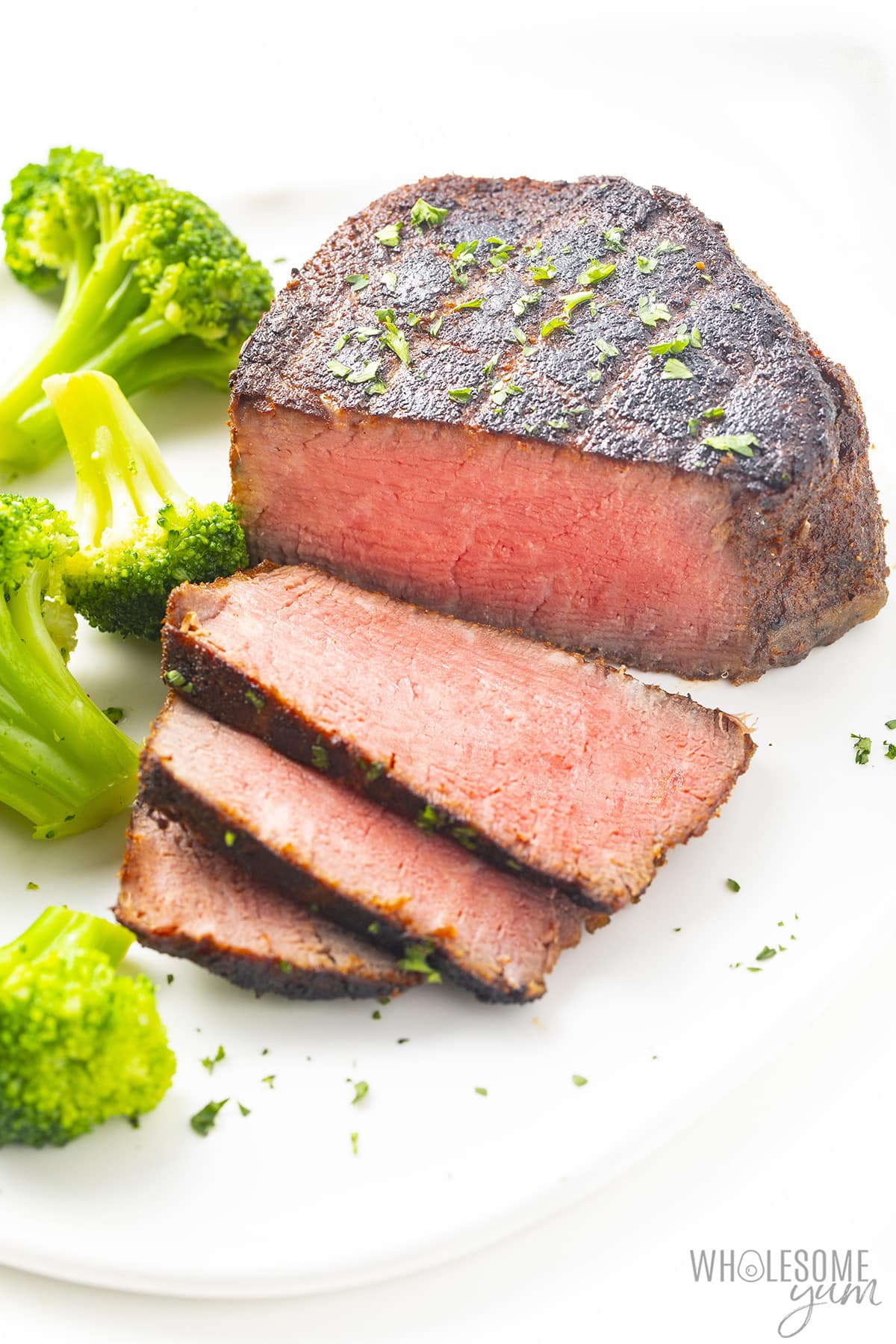
Ingredients & Substitutions
This section explains how to choose the best ingredients for reverse sear steak, what each one does in the recipe, and substitution options. For measurements, see the recipe card below.
- Steak – I used filet mignon, as it’s my favorite cut, but other good choices are top sirloin (only the thick kind), ribeye, porterhouse, or t-bone. Reverse seared steak only works with thick-cut steaks – at least 1.5 to 2 inches thick! If your steaks are thinner, they will overcook when you sear them after the oven. The traditional top sirloin steak method (which goes from stovetop to oven instead) works better for thin steaks.
- Seasoning – I used and highly recommend Montreal steak seasoning (with salt included), shown below. The flavor is unbeatable! But you can also simply use sea salt (or kosher salt) and black pepper.
- Avocado Oil – For searing. Any heat-safe oil will work.
- Butter & Garlic – These are optional, but adding butter and whole peeled garlic cloves to the pan halfway through searing adds loads of flavor. Avoid minced garlic, as it will burn.
How To Reverse Sear A Steak
This section shows how to reverse sear steak, with step-by-step photos and details about the technique, to help you visualize it. For full instructions, including amounts and temperatures, see the recipe card below.
Dry Brine
- Dry. Pat the steaks dry with paper towels.
- Season. Season generously with steak seasoning on all sides (top, bottom, and edges). Gently rub the seasoning into the steaks so that it sticks well. Roll the edges in any seasoning that falls off.
- Dry brine. I highly recommend this optional step! Place an oven-safe wire rack onto a baking sheet. Place steaks on top and refrigerate overnight, or up to 24 hours, to dry out the surface of the steak. (This will help get a great sear.) When you’re ready to cook the steak, set the pan out on the counter to bring it up to room temperature.
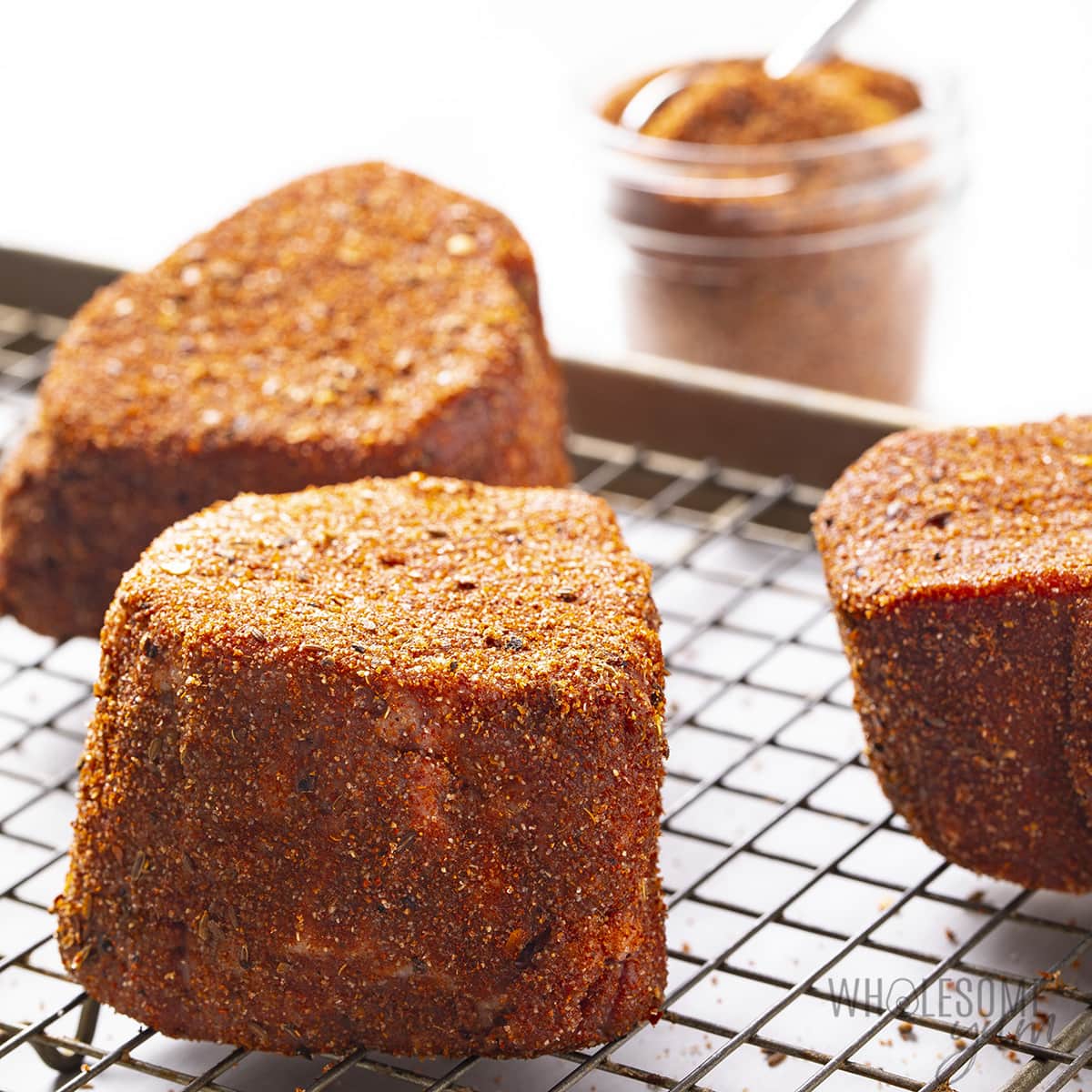
Slow Roast
- Roast. Bake the steaks (on the rack with baking sheet) in a preheated 200 degree F oven. Check the reverse seared steak time chart below for times.
- Check internal temperature. Use an instant read or probe thermometer to check the internal temperature, until it reaches the desired internal temperature.
FYI: After this step, the steaks will not look very different from before.
They will just be less bright red in color. The magic happens in the next step!
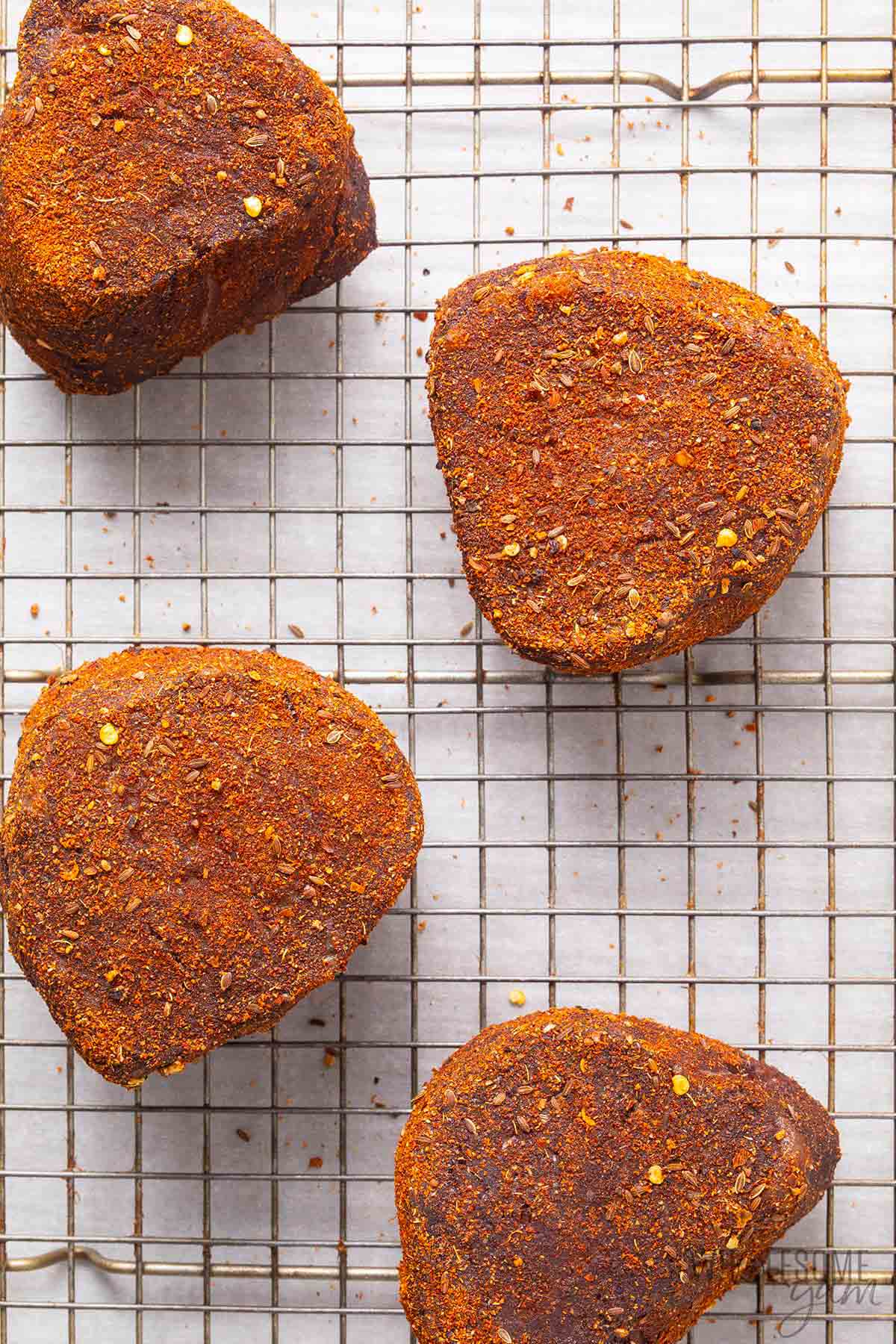
Sear
- Heat oil. Heat oil in a large cast iron pan over medium-high heat, until it’s screaming hot and just barely starting to smoke.
- Sear steaks. Add the steaks to the skillet in a single layer and cook until browned. Right before flipping, add butter and whole, peeled cloves of garlic into the pan. Use a large spoon to baste the butter over the steak. Flip and cook until browned on the other side.
TIP: While the steaks are cooking on the second side, use tongs to hold the edges against the pan to sear the sides one at a time.
Use the tongs to lift the steak, then hold each edge against the pan. Place back down and repeat with the other steaks. Work quickly, so that they don’t overcook!
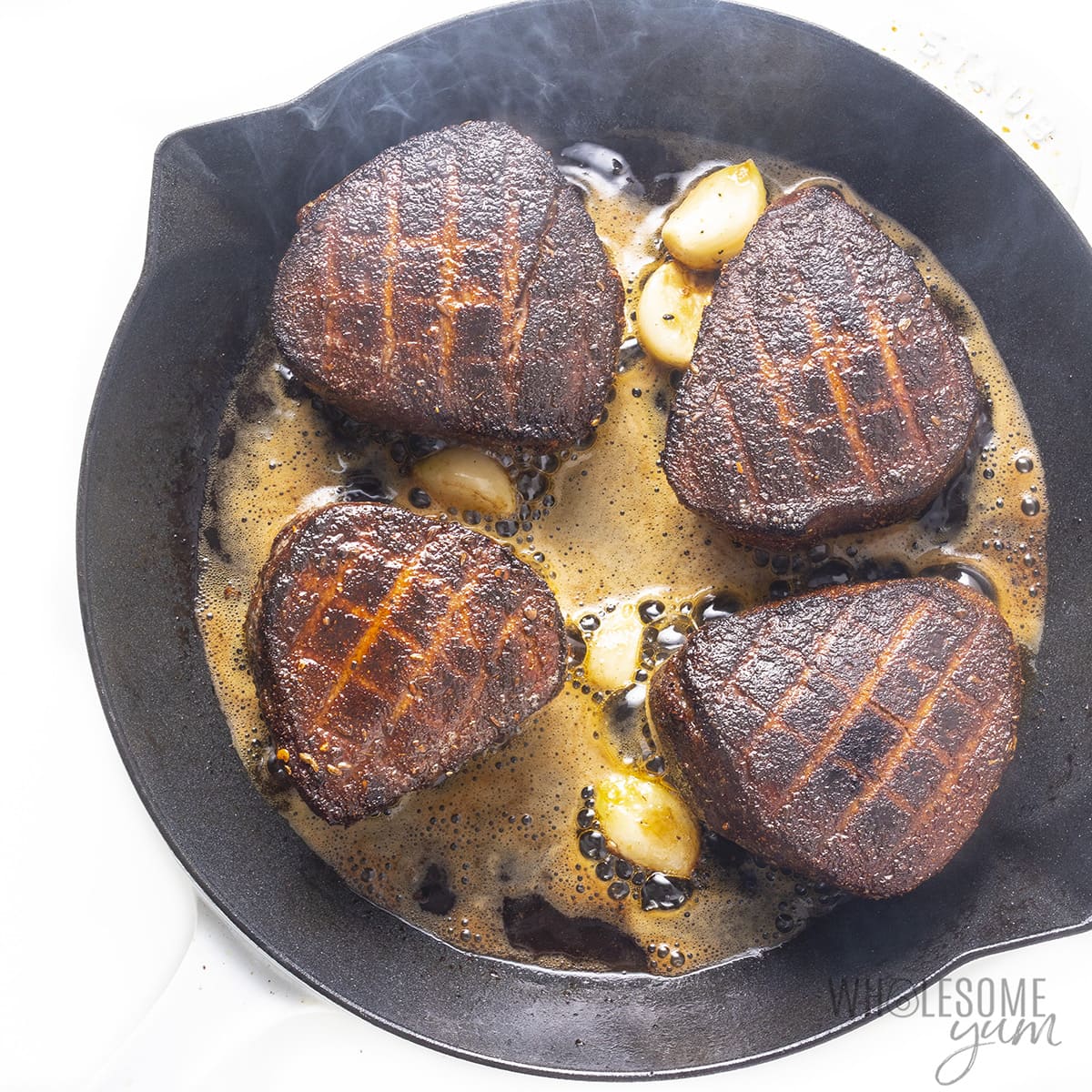
How Long To Reverse Sear Steak: Time Chart
The reverse seared steak time will vary based on size and thickness of your steak, as well as your oven, so use a probe thermometer and this reverse sear steak time chart as a guide. For 1.5 to 2 inch steaks:
| Steak Doneness | Reach This Temp In The Oven | Time In The Oven | Final Temp After Searing |
|---|---|---|---|
| Rare | 110 degrees F | 35-45 minutes | 120-125 degrees F |
| Medium Rare | 120 degrees F | 45-55 minutes | 130-135 degrees F |
| Medium | 130 degrees F | 55-65 minutes | 140-145 degrees F |
| Medium Well | 140 degrees F | 65-75 minutes | 150-155 degrees F |
| Well Done | 150 degrees F | 75-85 minutes | 160-165 degrees F |
After the initial time in the oven, finish the steak by searing on a screaming hot pan very quickly (see instructions above.). The temperature will rise another 10-15 degrees while searing, bringing the steak to its final temperature. Be sure to remove it right away to avoid overcooking!
Tips For The Best Reverse Sear Steak
- Salt and season liberally, ahead of time. Steaks can be seasoned simply with salt and pepper, or use my Montreal seasoning for amazing flavor. Julia Child’s rule of thumb is 1 teaspoon of salt per pound of meat. So for steak seasoning, you’d use the amount of seasoning needed to include that much salt. If you use the seasoning I used, the correct amount is 1/2 tablespoon Montreal steak seasoning per 8-oz steak.
- Dry out the steak in the fridge overnight. While this step is optional, I highly, highly recommend it. It’s the key to a crispy exterior and perfect sear. After seasoning, place on a wire rack over a baking sheet, and store in the fridge (uncovered!) for at least 8 hours, up to 24 hours.
- Let steak come to room temperature before cooking. This helps the steaks cook evenly.
- Slow roast on a rack at very low temperature. Using the wire rack to roast your steaks ensures that the heat can fully surround the steaks, for even cooking. The ideal temperature for a reverse sear steak in the oven is 200 degrees F. If your oven doesn’t go that low, set it to the lowest temperature possible.
- Use a good meat thermometer. Getting the reverse sear steak temperature right is an important step in this recipe. A quality instant read meat thermometer works, but a probe thermometer is even better because it will beep when the right temperature is reached. Using one of the thermometers linked here is ideal because they are very accurate and read very quickly. If you use a cheap one that takes a while to register the temperature, your steak may be overcooked by then.
- Sear in a heavy skillet. Cast iron skillets work best, because they get really hot and the heat is evenly spread out through the pan.
- Baste with garlic butter for extra flavor. The addition of garlic takes it up a notch and imparts a delicate garlic flavor to the steak. Plus, basting with butter does wonders to both the moisture and the exterior crust.
- Sear in batches if needed. If your steaks are large, cook in two batches so they can properly sear and not steam. Make sure to set aside half of the butter and garlic for the second batch and wipe out the pan in between batches.
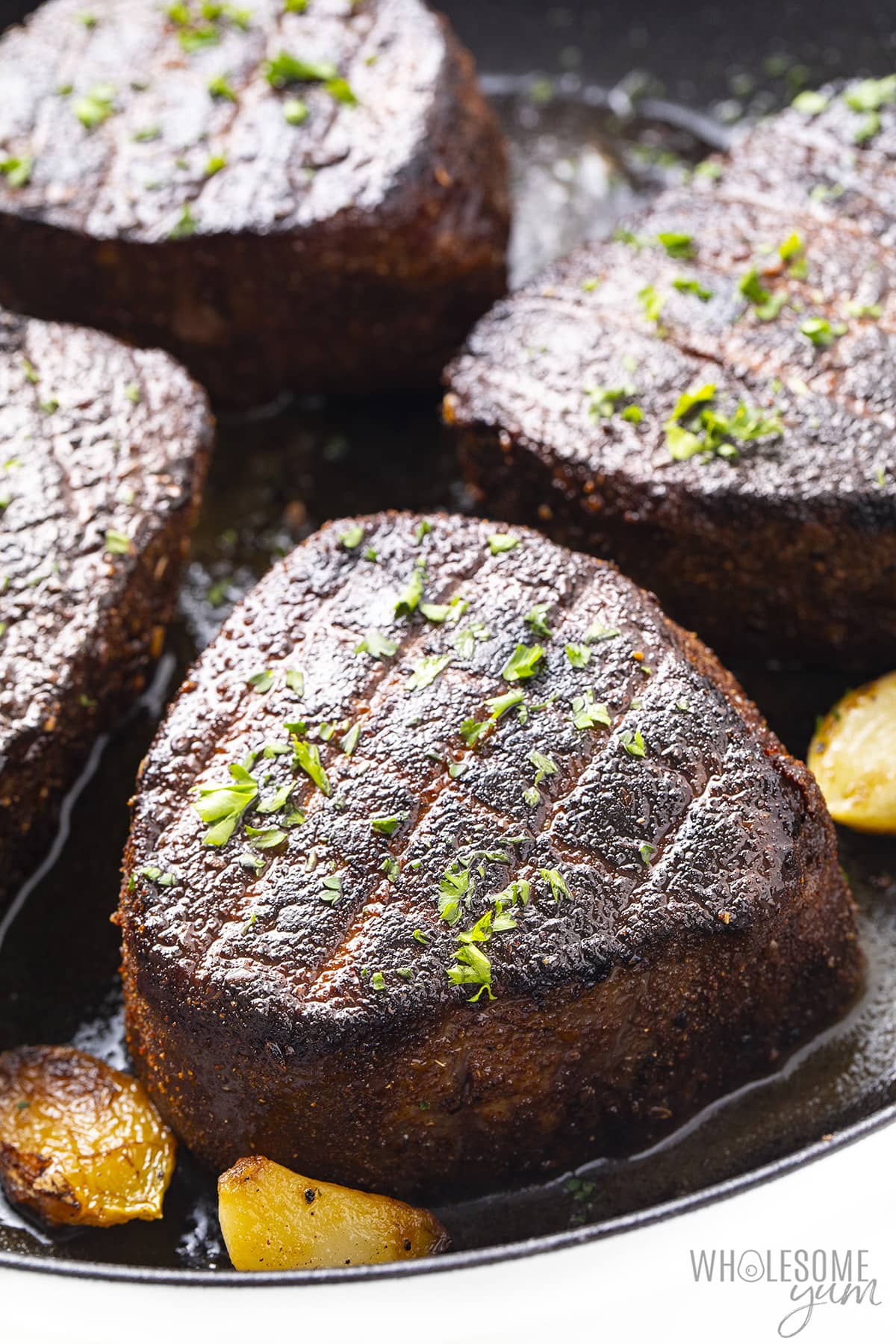
Variation: Reverse Sear Steak On The Grill
You can reverse sear a steak on the grill as well, instead of the oven. Here’s how:
- Heat your grill to 200 degrees F. This is the lowest setting on most grills, but on some, even the lowest may be higher than that.
- Use a probe thermometer to cook until it reaches the desired temperature. Grill over indirect heat and use the same reverse sear time chart above.
- Turn up the heat as high as it will go and sear both sides. Switch to direct heat for the sear. You’d skip the garlic and butter with this method, but can add some garlic butter on the side later if you like.
Reverse seared steaks on the grill won’t give them the same crust that a pan sear does, but they’ll still be perfectly cooked.
Storage Instructions
- Store: It’s best to reverse sear steak right before serving, but you can (and should!) season and dry out a day in advance. If you have leftovers, though, you can store them in the fridge for up to 3-5 days.
- Freeze: Cooked steak tastes best fresh, but you can freeze it for 2-3 months if necessary. Wrap tightly in foil, place in a freezer bag, remove as much air as possible, and place in the freezer.
- Leftover ideas: If you want to repurpose your reverse sear steak, try it in sandwiches (I use my keto white bread but any kind will do!), salads, or tacos.
Reheating Instructions
- Preheat the oven to a low temperature, such as 250 or 300 degrees F.
- Place the steaks in a baking dish and add a little broth to the bottom (this will create steam to keep moisture in). Seal the top with foil.
- Heat in the oven for about 10-15 minutes, or until warm.
- Alternatively, if maintaining the crust is important, wrap the steaks in foil and place directly on the oven grates to reheat. (Don’t place in a baking dish, as this is more prone to overcooking.)

What To Serve With Reverse Sear Steak
Now that you know how to reverse sear a steak, serve up this classic meal with classic sides. Here are a few of my favorite healthy side dishes to pair with it:
- Toppings – Compound butter or sauteed mushrooms make the perfect toppings for steak! Or, try my steak chimichurri sauce.
- Potatoes – Try oven roasted potatoes, mashed sweet potatoes, or for healthier alternatives, mashed cauliflower.
- Veggies – Reverse sear steaks go well with steakhouse sides, like creamed spinach, roasted asparagus or roasted brussels sprouts. You can also opt for sauteed zucchini or mixed roasted vegetables.
Recommended Tools
- Baking Sheet With Rack – Helps create air flow around the steaks. I also use this set up for cooking bacon in the oven and bacon wrapped asparagus.
- Probe Thermometer – The benefit of the probe is that you can set the desired temperature and an alarm will go off once the meat has reached that temperature. No need to constantly check, meaning you don’t let the heat out of the oven in doing so.
- Cast Iron Skillet – Everyone should have a good cast iron skillet. It’s a must-have for reverse sear steak recipes, of course, but also so many other recipes.
Reverse Sear Steak (Perfect Every Time!)
Reverse sear steak comes out perfect every time! Learn how to reverse sear a steak in the oven, with tender pink center and crispy crust.
Ingredients
Tap underlined ingredients to see where to get them.
Reverse sear steak:
Instructions
Tap on the times in the instructions below to start a kitchen timer while you cook.
Dry Brine:
-
Pat the steaks dry with paper towels.
-
Season the steaks generously with steak seasoning on all sides (top, bottom and edges), using a total of 1/2 tablespoon per 8-oz steak. Gently push and rub the seasoning into the steaks so that it sticks well. Roll the edges in any seasoning that falls off.
Optional Drying Step (recommended):
-
Place an oven-safe wire rack onto a baking sheet. Place steaks on top. Place the rack with the steaks, uncovered, into the refrigerator overnight, or up to 24 hours, to dry out the surface of the steak. (This helps get a great sear later.)
-
When you are ready to cook the steak, set the pan out on the counter for 30 minutes to bring it to room temperature.
Slow Roast:
-
Preheat the oven to 200 degrees F (93 degrees C).
-
Place the steaks (with baking rack and baking sheet) into the oven. Roast until the steak reaches your desired temperature:
* 110 degrees for Rare – about 35-45 minutes
* 120 degrees for Medium Rare – about 45-55 minutes
* 130 degrees for Medium – about 55-65 minutes
* 140 degrees for Medium Well – about 65-75 minutes
* 150 degrees for Well Done – about 75-85 minutes
(Note: These are NOT final temperatures, just the temperature that the steaks need to reach in the oven! The temperature will rise an additional 10-15 degrees when searing later.)
-
Use an instant read thermometer, or even better a probe thermometer, to check the internal temperature starting at 25 minutes and every 5-10 minutes after that, until the intended temperature is reached. Once steaks reach the temperature you want, remove them from the oven immediately and set aside.
Sear Steaks:
-
Heat 1 tablespoon (14.8 ml) of oil in a large cast iron skillet over medium-high heat for about 2 minutes, until it’s so screaming hot that it just barely starts to smoke.
-
Add the steaks to the skillet in a single layer. (If your steaks are large, you can do this in two batches.) Cook for 1-2 minutes, until a browned crust forms on the bottom.
If using the optional butter and garlic, add them right before flipping, placing the garlic cloves directly into the butter as it starts to melt. (If cooking steaks in batches, use half the butter and garlic for each of the two batches.)
Allow the garlic to sizzle in the butter and use a large spoon to baste the butter over the steak occasionally while finishing off the sear on the other side. (You can tilt the pan to help gather the butter for basting, keeping the garlic in the butter.)
-
Flip once and cook for 1-2 minutes again, until browned on the other side.
While browning the second side, use tongs to hold the steaks’ sides against the pan to sear the edges one at a time (the other steaks will sear on the 2nd side while you sear the sides of one steak).
-
If working in batches, remove the finished steaks from the pan and cover to keep warm (or serve right away). Wipe down the pan, and reheat with additional oil.
Repeat the searing steps above with the remaining butter and garlic, if using.
-
Serve immediately (no need to rest!). Slice against the grain.
Did You Like It?
Leave a rating to help other readers, or get the recipe sent to your inbox.
Recipe Notes
Serving size: 1 8-oz steak
Nutrition info was calculated using filet mignon and does not include the garlic cloves, which are used for flavor and might not be eaten. You can eat them if you like, though!
Nutrition facts are provided as a courtesy. Have questions about calculations or why you got a different result? Please see our nutrition policy.
© Copyright Maya Krampf for Wholesome Yum. Please DO NOT SCREENSHOT OR COPY/PASTE recipes to social media or websites. We’d LOVE for you to share a link with photo instead. 🙂
How To Reverse Sear A Steak
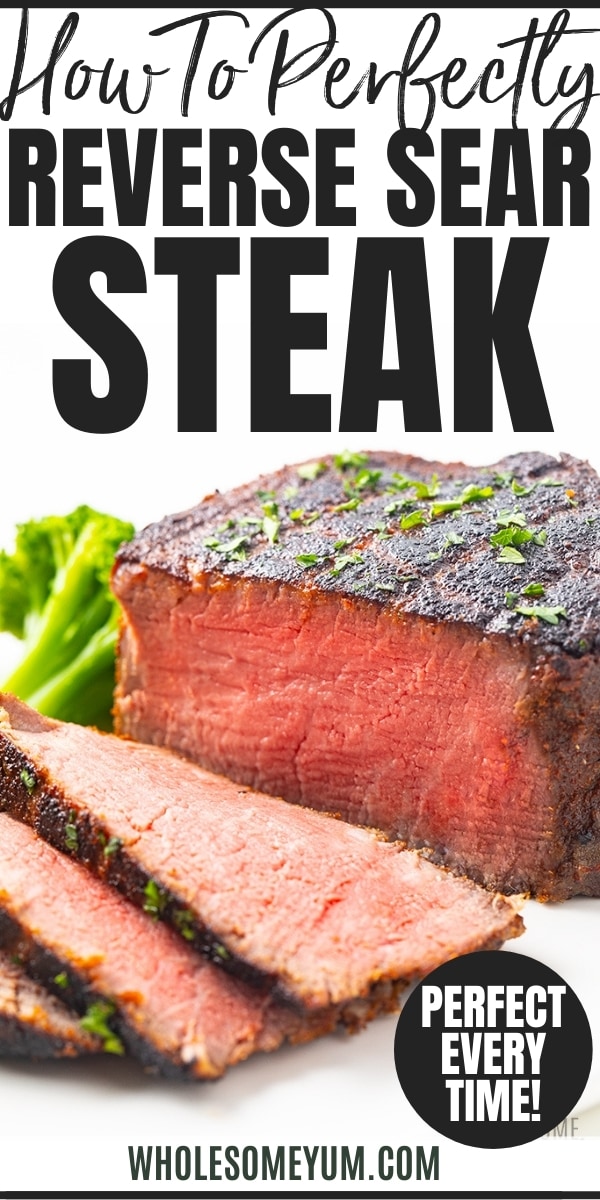
 My
My Shop
Shop Wholesome Yum
Wholesome Yum
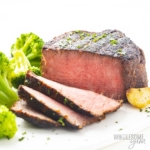

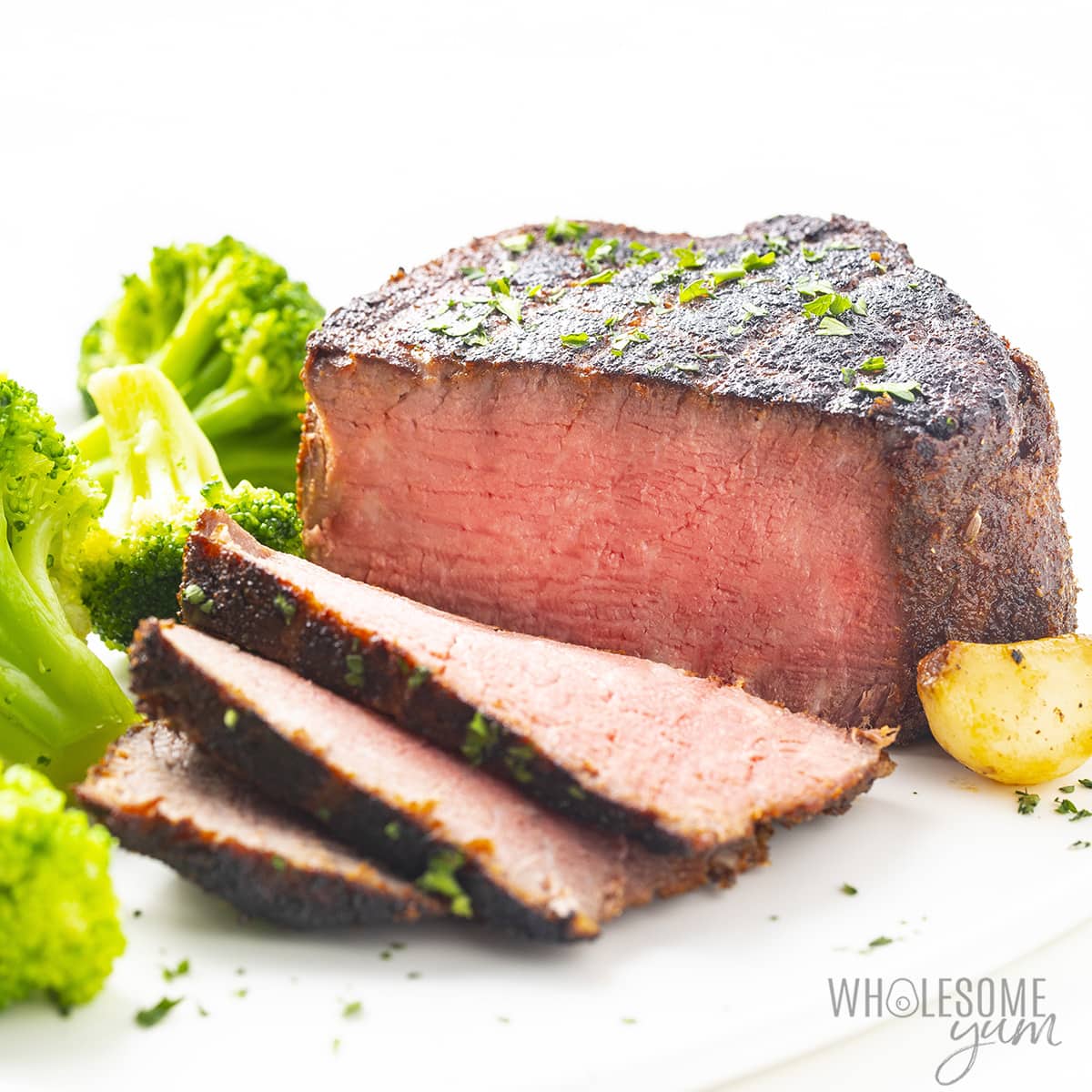
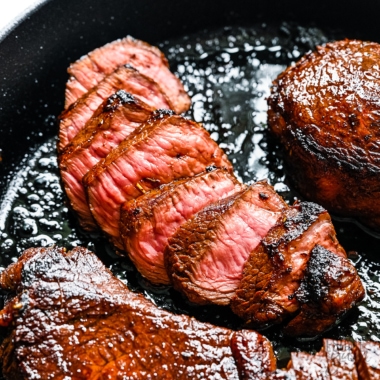
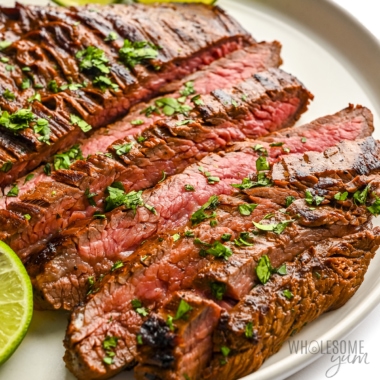
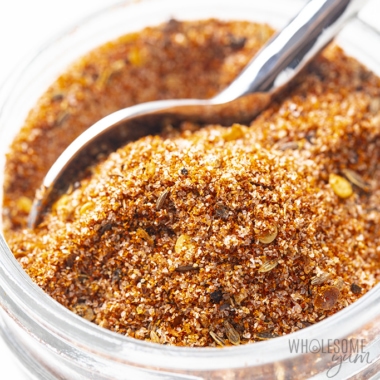
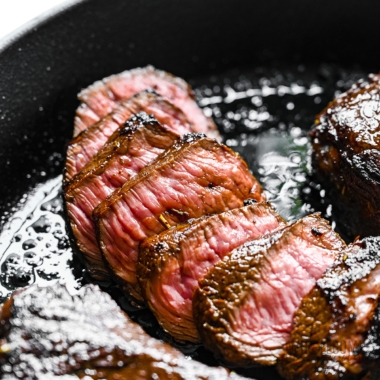
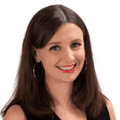





10 Comments
CC
0I would so love to do this recipe but living in an apartment with a smoke detector directly over the kitchen will definitely have everybody running for the door and calling the Fire Department! But it looks so good!
Colleen
0Made this yesterday- perfect medium rare! I can now make steaks in my apartment.
Theresa
0Can I bake the steak to the desired temperature and then wait a couple of hours before searing it? I’d like it as a quick meal after a couple of hours at the beach.
Wholesome Yum D
0Hi Theresa, I don’t recommend doing that for this recipe.
Natasha
0I made this recipe and it turned out amazing! It was evenly pink inside, so tender and delicious!
Kristyn
0This makes for the perfect date night in meal! It’s juicy, tender, & delicious!!
Toni
0This recipe is so perfect and really easy to follow! Thank you! I will definitely recommend this recipe to my friends!
Lisa
0Looks awesome!
Justine
0I have heard this is the best way to cook a steak, but wasn’t sure exactly how to do it.
Nellie Tracy
0Great method! So delicious!!